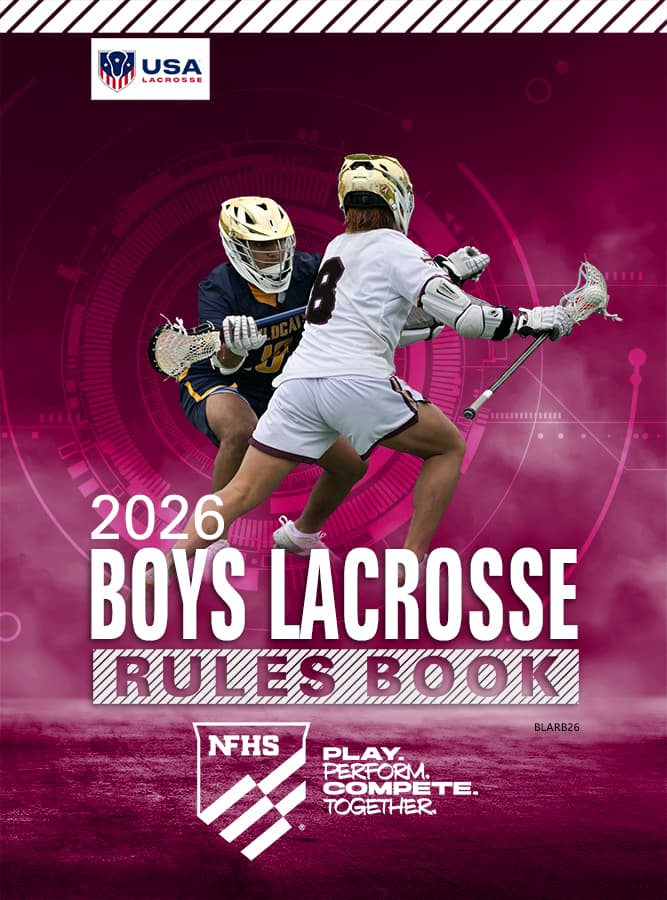
Lacrosse Boysrules
- Home/
- Sports/
- Lacrosse Boys/
- Rules
rule books
Print books

Rules publications, including rules books, case books and manuals, contain the official rules for high school sports and are designed to explain all aspects of the sport.
Print books - Purchase Print Books
digital books

Rules publications are available in an online format through NFHS Digital, the online platform for NFHS rules publications.
digital books - NFHS Digital
Lacrosse Boys Rule Changes
- 1
Boys Lacrosse Rules Changes - 2026
July 10, 20251-2-12d: Requires a cone be placed at the corner of the coaches area and the team area to clearly mark the team area.
Rationale: Adding a cone to clearly mark the team area in situations where lines are not required, assists in keeping the players within the designated team area without requiring additional field markings.1-9-1b(4 & 5): Eliminates the restrictions on color and prohibits items attached to the tooth and mouth protector that do not support the function of protecting the teeth and/or mouth.
Rationale: Aligns tooth and mouth protector rules with other NFHS sport rules requiring tooth and mouth protectors.1-9-1h(3): Modifies uniform number size on the back of the jersey by decreasing the minimum height to eight inches – matching the minimum height requirement on the front of the jersey.
Rationale: Aligns with other NFHS sport rules for number sizing while maintaining appropriate visibility for officials.1-12: Requires a working horn be accessible at the sideline table.
Rationale: Allows a coach to call for a double horn from the field without delayed communication to the press box.3-5-1 & 2 (NEW): Establishes that an interrupted game that cannot be resumed on the same day is considered complete if 75% of playing time has elapsed.
Rationale: Provides a procedure for interrupted play to assist host management while allowing state associations to develop modifications to game-ending procedures.4-3-3e: Allows an official to assess a delay of game penalty if player positioning on the face off must be adjusted repeatedly.
Rationale: Clarifies the current practice of penalizing faceoff players who need to be repeatedly adjusted.4-8: Clarifies that a goal is scored if the ball is or becomes loose behind the plane regardless of who caused the ball to cross the line.
Rationale: Creates consistency in awarding a goal when the ball becomes loose behind the plane and when a ball is loose and crosses the plane of the plane of the goal line.4-18-4 PENALTY; 5-6-2 (NEW): Reclassifies the foul for a player, other than the properly equipped goalkeeper, that enters the crease with the intent to block a shot as a personal foul for illegal equipment.
Rationale: Minimizes risk by discouraging players from acting as a goalkeeper by making the penalty more severe and removing the official’s responsibility to remember if it was the first occurrence or subsequent attempts.4-22-1c: Eliminates the five seconds awarded to a goalkeeper to re-enter the crease on any restart.
Rationale: Aligns treatment of the goalkeeper as a field player when it comes to injury or equipment issues while outside the crease while discouraging goalkeepers from leaving the crease and eliminating the need for an official to judge whether a goalkeeper has left the crease in an attempt to delay the game or for a legitimate purpose.6-3-2c: Adds hooking, lifting, or pinning an opponent’s body with the crosse in describing illegal actions related to holding.
Rationale: Additional descriptors help define holding and create a clearer understanding of illegal actions trending in the game.6-5-2y: Establishes that the loss of a helmet is an illegal procedure.
Rationale: Minimizes risk by increasing the penalty for a player losing a helmet during play encouraging players to ensure chin straps are properly worn and helmets are secure during play.7-3: Establishes consistency in penalty administration by moving the restart to laterally outside the goal area when the ball crosses the end line before or after the penalty occurs.
Rationale: Simplifies all restarts after penalties by administering them at the same restart point, regardless of any conditions.2026 Boys Lacrosse Major Editorial Changes
1-2-9: Requires all equipment to be kept in the bench area at least 6 yards away from the sideline.
1-3-2, 1-4: Recommends a flat-iron goal for all surfaces keeping up with trends in equipment and minimizing risk of injury.
1-7-3 thru 6: Reorganizes crosse construction rules by clearly identifying what is illegal and what must be fixed without penalty.
1-9-2a(1): Allows undergarments on the top or bottom to be white, gray, black or one of the team’s official colors.
2-5-2: Updates the recommended officials’ uniform.
4-3-1 EXCEPTION NOTE (NEW): Adds new note to rule exception for a faceoff clarifying where the ball is awarded when the offended team has three players serving penalty time.
4-19-1: Clarifies that a goal will be disallowed if a player jumps without possession, catches a pass, shoots and lands in the crease.
4-24: Restructures language for clarity.
7-6: Restructures language for clarity.
Official Lacrosse Signals: Adds new signal for Check Involving the Head/Neck or Defenseless Player.
2026 Boys Lacrosse Editorial Changes
1-2-7; 1-5; 1-6-3; 1-7-1; 1-9-1e; 1-9-1g; 1-9-1h NOTE; 1-9-1h(9); 1-10-1c; 2-10-2; 4-3-3b; 4-3-3l, m, n; 4-6- 2 thru 4; 4-13e; 5-4-1 & 2; 5-4-5; 5-4-6; 5-4-7 PENALTY; 5-5 NOTE; 5-6; 5-8; 5-10 PENALTY; 6-5-2t; 6-6-2; 6-12; 7-2e; 7-2f
2026 Boys Lacrosse Points of Emphasis
Properly Wearing Equipment
Personal Foul – Contact with the Head/Neck
Sportsmanship and Role of Head Coach
Pregame Responsibilities

